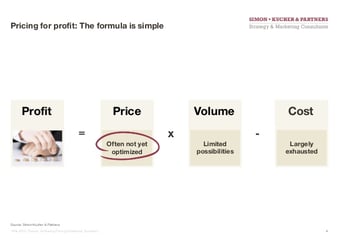I’m not a pricing expert.
 In this blog and previous ones on pricing, I borrow extensively from Hermann Simon’s Confessions of the Pricing Man: How Price Affects Everything efforts.
In this blog and previous ones on pricing, I borrow extensively from Hermann Simon’s Confessions of the Pricing Man: How Price Affects Everything efforts.
From Simon’s work as well as Peter Drucker’s research, pricing is an unexplored strategic lever in most businesses.
Peter Drucker called it the “most neglected area of marketing.”
Drucker saw a clear link between pricing and profit. He also sensed there is an enormous improvement potential simply by a business pricing it’s products and services right.
There are four decisions, in growing your business, you must get right or risk leaving significant revenues, profits, and time on the table.
These four decisions: People, Strategy, Execution, and Cash generate the following outcomes inside your business:
|
DECISION |
OUTCOME |
|
People |
Harmonious Culture of Accountability |
|
Strategy |
Top Line Revenue Growth |
|
Execution |
Profit |
|
Cash |
Oxygen and/or Options |
Pricing then is part of your Execution Decision.
We explored examples of companies with extraordinary low price strategies in High Prices or Low Prices Better for the Profit and the Survival of a Company?
Aldi, IKEA, H&M and Zara all had specific approaches to help them achieve leadership in their business category while achieving strong profit margins.
These provided specific examples. In The Most Promising Price Strategy to Pursue Simon shared between low, premium and luxury pricing, “none of them is easy.” If you are already in the low pricing area, or considering starting a business or product with low pricing, what does Simon offer as general strategies to win with low pricing?
Success Factors for a Low-Price Strategy
The list of companies who have succeeded with a low-price strategy tends to be short, but their strategies share a set of factors which help create and sustain that success.
- They began with that strategy from day one: All successful low-price companies focused on low prices and high volumes from the very beginning. In many cases, they created radically new business models. Simon is not aware of any company having made a successful transformation from a high-price or mid-price position to a low-price one.
- They are extremely efficient: All successful low-price companies operate with extreme cost and process efficiency, which enables them to enjoy good margins and profits even while charging low prices.
- They guarantee adequate and consistent quality: With poor and inconsistent quality, success is unlikely, even if you offer low prices. Sustainable success requires adequate and consistent quality.
- They have a strong focus on their core products: The term no-frills is often applied to airlines, but it could apply to companies such as Aldi or Dell as well. They do nothing that isn’t absolutely required by the customer. That saves costs, without putting the essential value to customer in jeopardy.
- They have a high-growth, high-revenue focus: This creates economies of scale which they exploit to the greatest extent possible.
- They are procurement champions: That means they are tough and forceful in their purchasing, but not unfair.
- They have little debt: Only very rarely do they turn to banks or debt markets for financing. Instead they rely on self-financing or supplier credit.
- They control as much as they possibly can: This means they carry only their own brands (Dell, Ryanair, IKEA); even Aldi ’s assortment is over 90 % private label. They also exercise strong control over the entire value chain.
-
 Their ads focus on price: To the extent they even advertise at all, they focus almost exclusively on price (Aldi, Lidl, Ryanair).
Their ads focus on price: To the extent they even advertise at all, they focus almost exclusively on price (Aldi, Lidl, Ryanair). - They never mix their messages: Almost all of the successful “low price–high profit” companies stick to an “everyday low price” strategy rather than a “hi-lo” which relies on frequent temporary promotions.
- They understand their role: Most markets have room for only a small number of “low price–high profit” competitors, often just one or two.
In the case of low price strategy Simon offers these insights: “Yes, it is absolutely possible for a company to achieve consistently high profits with low prices. But only a few who try are ever blessed with that kind of success. It only happens when a company has a clear, significant, and sustainable cost advantage over its competitors. The skills to pull that off must be anchored in the company and its culture from its very beginning. I doubt that a company with another operating style and tradition could make the switch and meet the “low price–high profit” requirements. The key challenge is to establish an acceptable (not a minimal) level of value to customer, delivered with the highest cost efficiency. This category of companies also places special demands on executives, entrepreneurs, and managers. Only those with the will and the nerves to be Spartan, thrifty, and stingy day in and day out should venture into the realm of low-price positioning.”
Pricing Strategy is one of many pieces of your company’s overall strategy. The result of getting your strategy right is top line revenue growth. Pricing as shared earlier in this blog is a result of getting Execution right in your business. We’ll be exploring Strategy, Execution, People and Cash as the Four Decisions that drive growth in your business at our Scaling Up Business Growth Workshop Cedar Rapids, IA, Wednesday, November 2nd at The Hotel Kirkwood Center. Plan to attend to make 2017 your best year ever. You can register by following the link above or by clicking on the links in the announcement in the upper right hand column of this blog.
Simon includes three other pricing strategies in his book, Ultra-low Price, Premium Price, and Luxury Goods Pricing Strategy. We explore these in our next blog.






.jpeg?width=150&height=135&name=Hand%20with%20marker%20writing%20the%20question%20Whats%20Next_%20(1).jpeg)

